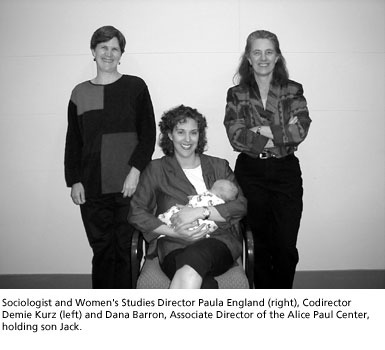
Breaking the Silence
The Rise of Women’s Studies at Penn

Church fathers have long held that sin, suffering, and death came into
the world through Eve, the mother of us all. She was the first to eat
the Forbidden Fruit and then tempted Adam to partake of it, thus leading
all her children into exile from paradise. Tertullian, a second-century
patriarch, called her “the devil’s gateway.” For centuries,
religious authorities taught that all women bear the blame of Eve’s
transgression and that the creation story justified women’s inferior
social standing.
After the Fall—and Before
Feminist historian Gerda Lerner, Hon’99, a professor at the University
of Wisconsin at Madison, has argued that the long history of women’s
social and sexual subordination is rooted in “men’s power to
define.” In The Creation of Feminist Consciousness she writes,
“The hegemony of patriarchal thought in Western civilization . .
. is built upon the systematic silencing of other voices,” mostly
the voices of women. Before the creator had fashioned a “help meet”
from Adam’s rib, he brought each newly made creature before the first
man, “and whatsoever Adam called every living thing, that was the
name thereof” (Genesis 2:19). Even before the Fall, it seems, things
had begun to go awry in Eden.
 Paula
England, sociology professor and director of the Women’s Studies
program, wrote her Ph.D. dissertation in the early 70s on the pay gap
between the sexes. “I searched all these social science journals
and found maybe ten articles that had been written over the previous ten
years.” There was plenty of information on women’s wages in
the census data, she points out, “but nobody thought it was very
important.”
Paula
England, sociology professor and director of the Women’s Studies
program, wrote her Ph.D. dissertation in the early 70s on the pay gap
between the sexes. “I searched all these social science journals
and found maybe ten articles that had been written over the previous ten
years.” There was plenty of information on women’s wages in
the census data, she points out, “but nobody thought it was very
important.”
“Academia had not focused until the 1970s on the study of women and gender,” asserts Demie Kurz, codirector of Women’s Studies. “The study of history and sociology and psychology was really the study of men’s history and men’s sociology and men’s psychology.” Thirty years ago, there were few female professors, and the curriculum was virtually silent on the experience of half the population. It wasn’t “penis envy,” as Freud suggested, that women suffered from; it was the enforced stilling of their organ of speech.
Today, Kurz notes, it’s hard to keep up on gender studies in your own field, and what started out as scholarship from a female perspective has branched into inquiries along gender, race, and class tributaries in almost every academic discipline. “Gender is a major organizing principle in every society,” she explains, “so the way most of us see it is that gender is integral to anything you study.”
Women’s Studies at Penn
Created in 1973, the School’s program in Woman’s Studies is
among the nation’s oldest. Organized efforts to set up a program,
led by Women for Equal Opportunity at the University of Pennsylvania,
were already underway when protestors staged a sit-in outside President
Martin Meyerson’s office in April of 1973. The action followed a
rally on the College Green, where a group of 200 students, faculty, and
staff expressed general dissatisfaction over women’s treatment on
campus and a particular concern over the administration’s failure
to respond to several rapes. Besides prodding University officials to
act on security demands, a new Women’s Center, a Women’s Studies
program, and other changes came out of women’s taking charge of their
own campus destiny.
About 75 courses a year are offered in Women’s Studies; most are cross listed with other disciplines. Around one-third of the undergraduate student body takes at least one of them. A major and a minor as well as a graduate certificate are available in Women’s Studies, but England says the program is more intent on spreading gender-themed courses throughout the curriculum. “I think it would be very helpful for students’ education if they could reconsider some of the stereotypes they hold or the beliefs they were socialized with that might not be very helpful to their own development or to their kids’ development.”
Dana Barron, Gr’95, is the associate director of the Alice Paul Center for Research on Women and Gender. She calls the center “a bridge” that supports the conveyance of data and other information from academia to policy makers and advocates working to improve the lives of women, children, and families. She believes that gender study, like writing and understanding quantitative data, should be a basic competency in a liberal arts education. Graduates who leave without taking a Woman’s Studies course or doing research that uses gender as a “lens of analysis” have not fully learned their discipline, she contends. “Without thinking about that stuff, you’ve left out something fundamental, not just to what you’ve majored in but to the way you’re going to live your life.”
Gender can determine your salary, what you think your role and your partner’s responsibilities are in parenting and in establishing a career, how you think about yourself or about political issues, and how you behave in almost every area of your life. “Once you start thinking about things in terms of gender,” Barron points out, “they start to look different—and so does your place in the world.”